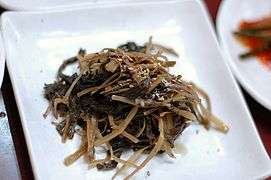Doellingeria scabra
| Doellingeria scabra | |
|---|---|
| | |
| Doellingeria scabra | |
| Scientific classification | |
| Kingdom: | Plantae |
| (unranked): | Angiosperms |
| (unranked): | Eudicots |
| Order: | Asterales |
| Family: | Asteraceae |
| Genus: | Doellingeria |
| Species: | D. scabra |
| Binomial name | |
| Doellingeria scabra (Thunb.) Nees | |
| Synonyms | |
|
Aster scaber | |
Doellingeria scabra is a perennial herb of the Compositae family from Eurasia. It is frequently found in wild mountain regions of Korea, eastern Russia, China and Japan.
Doellingeria scabra thrives in the dry mountain ranges of Korea. It is known for its distinctive fragrance and taste, and is frequently used in Korean cuisine. Known among locals for its medicinal use, studies show it contains many beneficial compounds. It's Korean name is chamchwi(참취, "true chwi"), and it is often simply referred to as chwinamul(취나물, "chwi namul") by the Korean locals.[1]
Distribution
Doellingeria scabra is native to Eurasia, which includes eastern Russia, China, Japan, and Korea. It is actively cultivated in temperate regions of Korea for varying uses.[2]
Habitat and Ecology
Doellingeria scabra is found in woods and thickets. Low hills and mountains frequently harbor its growth. Forest clearings and warm temperate areas suit it well. Moist soil and full sun conditions are ideal for A. scaber Thunb. It can be cultivated in lightly sandy, loamy, or clay soils. Adequately drained soil is needed. It cannot grow in the shade.[3]
Description
Doellingeria scabra grows up to 1.2 meters (4 ft). Its stems stand tall. Its hermaphrodite flowers bloom between August to October. Its seeds ripen between September to November. Insect pollinators such as bees and flies aid pollen exchange. It is capable of self-fertilization. The palmate venation leaves are green and Cordate-shaped. Its edges are serrated; jagged and resemble saw blades. Trichome can be found all over its surface.[3]
Use
Culinary
Korea

In Korean cuisine, chamchwi along with other chwinamul varieties are often used as the main ingredient of herbal side dishes called namul. It is also one of the ingredients that frequently feature in bibimbap recipes. It can be used as a herb in kimchi, rice, and even Korean-style Italian pasta dishes. It is also used as a ssam vegetable.
Dishes
- chwinamulbokkeum – a type of bokkeum, made by parboiling and then stir-frying the young leaves of chamchwi with ground beef, chopped scallions, vegetable oil, and toasted sesame seeds.
- chwinamulkimchi – a type of kimchi, made by soaking chamchwi in brine for three days, then seasoning it with soybean starch, liquorice broth, julienned red chilli, and minced ginger.
- chwinamulmuchim – a type of namul, made by blanching young chamchwi, squeezing it to drain water, and seasoning it with chopped scallions, chopped garlic, soup soy sauce, perilla oil, and toasted sesame seeds. It can also be seasoned with gochujang or doenjang, maesilcheong(plum syrup), vinegar, and sesame oil.
- chwissam – a type of wrap dish, made by wrapping julienned and stir-fried pork, balloon flower roots, eastern brakenfern, green chilli, and carrot with stir-fried chamchwi, then binding the wraps with wild chive.
- chwitteok – a type of tteok(rice cake), made by pounding soaked rice and blanched chamchwi into powder, then steaming them, and pounding the steamed cake again. The tteok is usually brushed with sesame oil.
- insam chwinamul – a type of namul, made by seasoning blanched ginseng and blanched, soaked, and drained chwinamul with soy sauce, sesame oil, chopped scallions, and minced garlic, and then stir-frying them. Toasted sesame seeds are sprinkled on top before served.
Medicinal
Traditional Eastern medicine used Doellingeria scabra for its various medicinal effects. Ground D. scabra can be used to treat external wounds and snakebites by applying directly to the skin. Studies have shown that D. scabra aqueous extract can be used to improve immune response via increased macrophage activation in mice over the course of 4 weeks. D. scabra most notably upped pro-inflammatory cytokines, nitric oxide, and expression of iNOS and COX-2.[4] It displays anti-carcinogenic, anti-oxidant, and anti-inflammatory activities. When treated with reactive oxygen species, its protective effect can be maximized by blanching with hypochlorite ion. Preparation time directly affects its anti-oxidant ability.[5] Caffeoyl quinic acid from its extract has shown to display inhibitory activity against HIV-1 integrase.[6]
See also
References
- ↑ Yung, Tae; Chung, Takayuki; Eiserich, Jason P.; Shibamoto (1993). "Volatile compounds isolated from edible Korean chamchwi (Aster scaber Thunb)". J. Agric. Food Chem. 41 (10): 1693–1697. doi:10.1021/jf00034a033.
- ↑ Aster scaber information from NPGS/GRIN, USDA, ARS, National Genetic Resources Program. Germplasm Resources Information Network - (GRIN) [Online Database]. National Germplasm Resources Laboratory, Beltsville, Maryland. Accessed May 5, 2014, http://www.ars-grin.gov/cgi-bin/npgs/html/taxon.pl?5657
- 1 2 Aster scaber - Thunb, PFAF Plant Database, Accessed May 5, 2014, http://www.pfaf.org/user/Plant.aspx?LatinName=Aster+scaber
- ↑ Kim, Jin; Park, Chang-Shin; Lim, Yunsook; Kim, Hyun-Sook (2009). "Paeonia japonica, Houttuynia cordata, and Aster scaber Water Extracts Induce Nitric Oxide and Cytokine Production by Lipopolysaccharide-Activated Macrophages". Journal of Medicinal Food. 12 (2): 365–373. doi:10.1089/jmf.2008.1013.
- ↑ Antioxidant Activity of Aster scaber Thunb. With Different Cooking Methods (LB409), Gun-Hee Kim1, Hye-Young Choi1 and Hee Sook Park, The FASEB Journal vol. 28 no. 1 Supplement LB409, April 2014, http://www.fasebj.org/content/28/1_Supplement/LB409.short
- ↑ Kwon, HC; Jung, CM; Shin, CG; Lee, JK; Choi, SU; Kim, SY; Lee, KR (2000). "A new caffeoyl quinic acid from aster scaber and its inhibitory activity against human immunodeficiency virus-1 (HIV-1) integrase.". Chemical & Pharmaceutical Bulletin. 48 (11): 1796–1798. PMID 11086919. doi:10.1248/cpb.48.1796.
External links
- PFaf
- AMNews
- jdm0777.com/jdm/chamchi.htm
- www.fasebj.org/content/28/1_Supplement/LB409.short
- Kwon, HC; Jung, CM; Shin, CG; Lee, JK; Choi, SU; Kim, SY; Lee, KR (2000). "A new caffeoyl quinic acid from aster scaber and its inhibitory activity against human immunodeficiency virus-1 (HIV-1) integrase". Chem. Pharm. Bull. 48: 1796–8. PMID 11086919. doi:10.1248/cpb.48.1796.
- www.ars-grin.gov